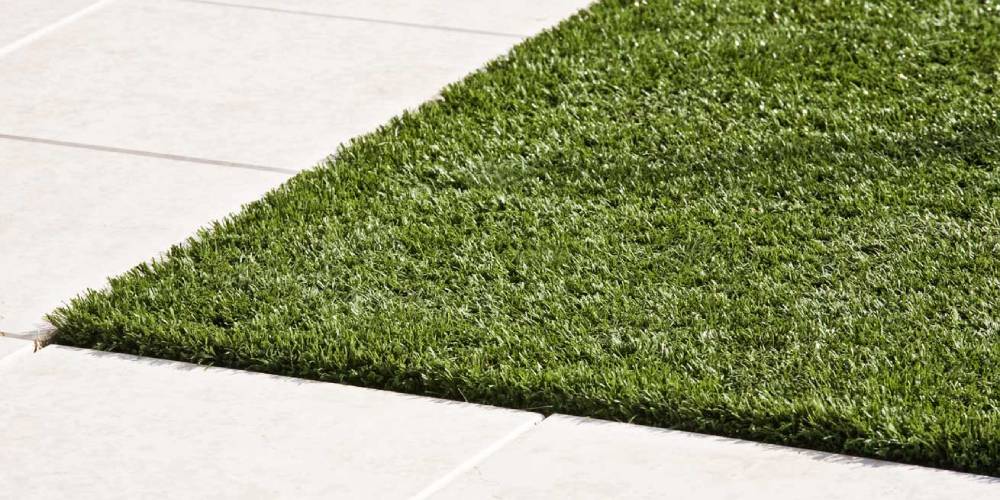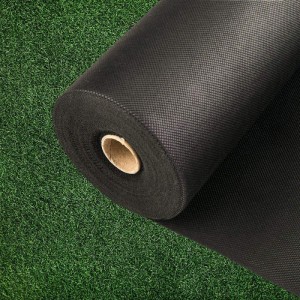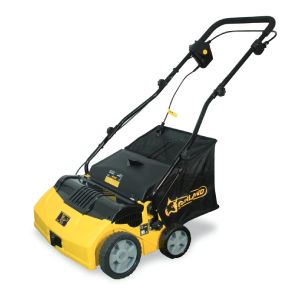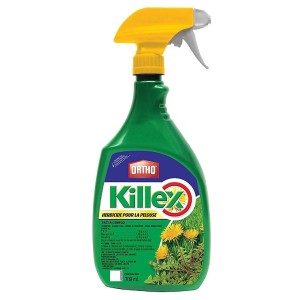- Duralawn
- Artificial Grass Maintenance
- Artificial Grass Weed Control
Artificial Grass Weed Control
Artificial grass weed control is most easily prevented during the installation process and when done so, you can expect many years of ultra-low maintenance weed-free artificial grass. The reason so many people choose synthetic turf in the first place is likely because of all the benefits of artificial grass. With a little bit of work up front you should very rarely encounter stubborn weeds like you often find in natural grass.

If you are reading this page and you haven't installed the artificial grass yet, you're in luck. There are many different ways to ensure that weeds don't ever grow and if they do they will be really easy to just pull from the surface because they are likely just locally seeds that have germinated from windblown seeds or transferred by an animal. You should familiarize yourself with upkeep including our list of artificial grass maintenance equipment that are best designed to keep synthetic grass looking great, healthy and ultimately preventing weeds.
Do You Need Weed Control Under Artificial Grass?
Artificial grass weed control should be considered for most projects but unfortunately it often gets skipped either due to the increased cost for the business or gets overlooked because of lack of eduction. There are circumstances where a weed membrane for artificial grass should absolutely be used such as grass going into an area that had preexisting weed problems. A weed membrane may also be needed when the installer is unable to use the required thickness of sub base gravel material due to grading restrictions.
The cost of weed barrier fabric and the time it takes to install is very minimal compared to the entirety of most projects. This makes it's a no brainer that it should be installed if there is any risk of future weed growth and potentially damaging the grass. The cost to fix the problem after the installation is complete is substantially higher than preventing weeds initially.
Artificial Grass Weed Control Prior to Installation
The best time to address weed growth is during the artificial grass installation process. It's during the preparation stage that the decision to use a weed membrane should be made, erring on the side of caution. A professional installation will likely include removal of 4 to 6 inches of existing organic material from the project area, including the removal of preexisting natural grass and 3 to 5 inches of soil. This step helps ensure that invasive weeds, roots and other vegetation are removed from the area so they don't rear their ugly head in the future.
After the grass, dirt and other organic materials are removed, the road crush should fill the cavity leaving just enough room for the height of the artificial grass. The road crush is levelled and packed, creating a layer that is near impossible to be penetrated by weeds. It's important that the crush layer is at least 4 inches in depth, allowing it to be compacted properly with a vibratory compactor creating a barrier almost as strong as concrete. The layer will help prevent weed growth and also provide a very sturdy base for the artificial grass to be fastened.
It's possible for weeds to grow through artificial grass when the road crush isn't thick enough or wasn't packed properly.
The final step to a near full-proof artificial grass weed control installation is the use of a high quality, commercial grade weed membrane fabric. A weed membrane should be made of woven fabric that allows water to drain through but prevents seed germination and weeds from growing up through the cloth. We'll discuss more about finding the best weed barrier for artificial grass below.
Best Weed Barrier for Artificial Grass
The best barrier for artificial grass weed control is a woven or non-woven polypropylene fabric with a textile strength of at least 2.0 ounces. In addition to being super resilient to wear and tear, it will prevent just about anything from growing, burrowing or poking up through it. This means that you won't see weeds, critters or roots penetrating through artificial grass for many years. Quality weed barrier landscape fabrics have warranties in excess of 20 years and are worth every penny when it comes to reduced maintenance and peace of mind.
Flarmor Heavy Duty Commercial Weed Barrier FabricIf you click on this link and make a purchase, we may earn a commission. |
|
Installing Weed Barrier Fabric
The best weed barrier for artificial grass should come on a roll at least 4' wide. The wider the roll the better as a wider roll will reduce the amount of seems that need to be stapled and potentially allow weeds to slither through. This of course will depend on the size of the project and in some cases you may want to consider a roll that is 8, 10 or 12 feet wide for the ultimate in weed protection and reduced seems.
For best artificial grass weed control we recommend overlapping the fabric seems by at least a foot. This foot of overlap will add extra protection from persistent weeds that seemingly grow anywhere like the incredibly hardy bindweed. You want the fabric to cover every corner of the area, paying attention to areas adjacent to a neighbours natural grass, a flower bed or high traffic areas. The fabric should be stapled around the entire perimeter every 12 to 18 inches and of course along the seems. Make sure the fabric is stretched taught so you don't promote any rippling when installing the artificial grass on top of the fabric.
Artificial Grass Weed Control and Elimination
If you or your installer didn't use adequate artificial grass weed control for your lawn, putting green, pet area or wherever you enjoy artificial grass, you may find success controlling the weeds that do end up growing. Unfortunately one of the disadvantages of artificial grass is weeds growing along the edges of the grass and even tiny weeds that grow in the infill seeds are transported through the air or by an animal such as a passing bird. Fortunately, the small weeds that grow in the infill can be surface pulled and the perimeter weeds can be controlled with a number of safe alternatives.
Artificial Grass Power Brush
One of the best tools for maintaining artificial grass and specifically preventing weeds is a power broom. The importance of grooming and cleaning artificial grass is even more imperative if you experience weed growth, have pets that use the grass area or a lot of leaves fall on the surface. An artificial grass power brush when used as part of your maintenance regime will prevent weeds before they take hold and can also be used to power brush away weeds that have taken hold. You should also consider using a leaf blower to keep leaves off the grass throughout the year and in the fall as part of artificial grass winter care preparations.
Garland Roll&Comb Artificial Grass Power BrushIf you click on this link and make a purchase, we may earn a commission. |
Weed Killer
The last line of defence for artificial grass weed control is a weed and moss killer spray. This should be considered a last resort because of the potentially harmful effects that herbicides can have on ourselves, our soil and water. A pre-mixed spray is convenient way to spot kill invasive weeds in artificial grass and isn't ideal for large areas. There are weed killer concentrates that can be used with a hose end sprayer and garden hose for large areas with troublesome weeds.
When using a pesticide always use extreme caution. Keep out of reach of children, wash hands after use, and always wear protective clothing.
Killex Weed Killer Spray for Artificial GrassIf you click on this link and make a purchase, we may earn a commission. |
Edger Board
An experienced artificial grass installer will be able to identify trouble areas where weeds may tend to grow. This could be in a front lawn adjacent to a neighbours highly fertilized natural grass or next to an external fence line where weeds are growing out of control. These areas will not only benefit from an artificial grass edger board for aesthetic reasons, the board will act as a barrier preventing weeds from shooting roots underneath the artificial grass. While an edger board alone will likely not prevent invasive weeds, it's a great line of defence when used in combination with a properly prepared crush base and a quality weed barrier fabric.
Artificial Grass Weed Control Alternatives
- Vinegar and Salt. A vinegar concentrate alone can kill most weeds or you can try mixing vinegar and salt together for an even more lethal combination for invasive vegetation growing through your artificial grass. This solution is best applied directly to the leaves with a spray bottle and you may even want to try adding some dish soap to this weed cocktail.
- Apple Cider Vinegar. Apple cider vinegar to kill weeds on artificial grass is yet another use for this wonder product. Apply the apple cider vinegar at full strength using a spray bottle for best results and wait a couple days to see if it is effective on your particular weed.
- Boiling Water. Pouring boiling water on artificial grass is an easy way to kill vegetation growing through or along the edged or synthetic turf. Bring the water to a boil in a kettle and pour directly onto the weed, being careful because scalding water will burn the skin. The boiling water will actively kill the weed and most living vegetation that is comes in contact with. This is a safe and effective way to kill most intrusive weeds on the spot.
- Alcohol. Any distilled alcohol like vodka will work to disrupt the health of weeds and can be applied similarly to vinegar and salt with a good spray. The ideal time is during the hottest part of the day when it's sunny out because the alcohol acts by causing dehydration in the vegetation.
- Block Sunlight. If you've ever heard of starving plants of sunshine, this is the principal of this artificial grass weed control alternative. It should only take a few days to see results after placing a piece of cardboard or anything that will prevent sunlight from reaching the unwanted weed. You may even want to consider trying one of the methods above in combination with blocking sunlight to the weed.
Artificial Grass Weed Control FAQs
Artificial grass weed control starts at the planning stage of any project and should include at the very least a weed barrier fabric. As each project will have its uniqueness and its own challenges you may have questions related to your specific installation. We've tried to cover as much as we could about how to manage weeds.
What is the best weed killer for artificial grass?
What is the best weed killer for artificial grass?
The best weed killer for artificial grass is a spray pesticide designed for spot cleaning troublesome weeds. It should be used as a last line of defence and only used when necessary because it does come with some risks. Always read the manufacturers instructions for safe use especially if children and pets use the area experiencing weeds.
How do you stop weeds from growing on artificial grass?
How do you stop weeds from growing on artificial grass?
The best way to provide the best defence against weeds growing on artificial grass is to use a 3 layer approach. Firstly, preexisting organics should be removed from the project area down to a depth of at least 4 inches and replaced with highly compacted crusher gravel chips. Secondly, an edger board should be used around the perimeter of most artificial grass areas to provide a barrier to invasive vegetation. Thirdly, a quality nylon weed membrane for artificial grass should be used if there's even a remote chance that weeds may become an issue for your project.
Does artificial grass stop weeds?
Does artificial grass stop weeds?
Artificial grass does not stop weeds on its own. The backing of most artificial grass has drainage holes punched through it to allow liquid to drain through. These holes are often where weeds like to penetrate up through the grass and subsequently makes artificial grass susceptible. It speaks to the importance of preparing artificial grass properly to prevent weeds.
How do I get rid of moss and weeds on my artificial grass?
How do I get rid of moss and weeds on my artificial grass?
Killing moss and weeds can be achieved with a powerful herbicide spray. This can either be done by using a premixed bottle of weed killer spray or using a concentrate combined with water from a garden hose, using a hose end sprayer. The latter is more suitable for large areas of moss growth that can occur on old artificial grass putting greens that experience a lot of moisture and inadequate drainage.
Can you jet wash artificial grass?
Can you jet wash artificial grass?
The process of jet washing artificial grass is often used when the infill material of artificial grass has become so infested with organic materials that it's near impossible to keep clean. This dirty infill will harbour germs, bacteria and provides a suitable area for weed growth. Jet washing will remove the infill with the ultimate goal of replacing the old material with a new clean infill. This process is important for artificial grass weed control if the infill is 10 years or older and you notice weeds germinating on the surface of the grass.
Disclaimer
Please use all appropriate and proper safety precautions when attempting projects on this website. All projects are attempted at the reader's own risk.
Duralawn® participates in the Amazon Services LLC Associates Program, as an Amazon Associate we may earn a commission from qualifying purchases.
Duralawn® artificial grass installations, products and service in Kelowna, Vernon, Penticton, etc since 2018.



